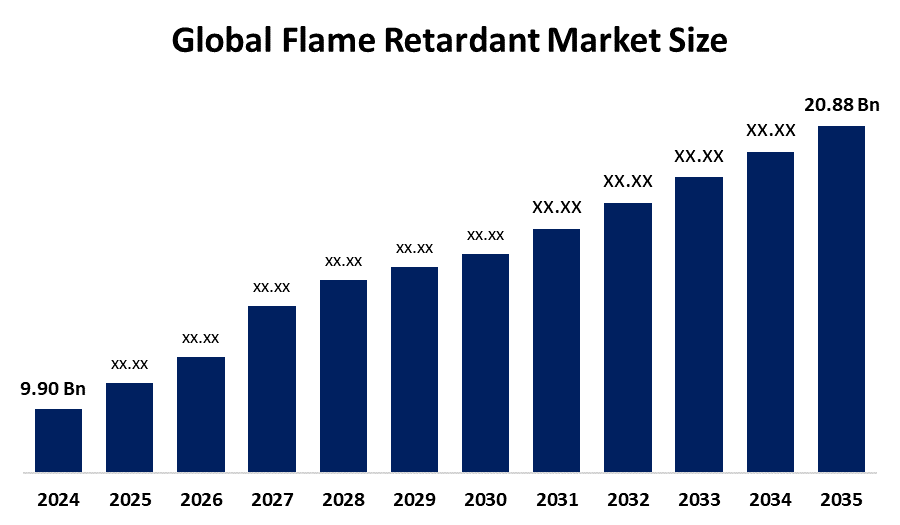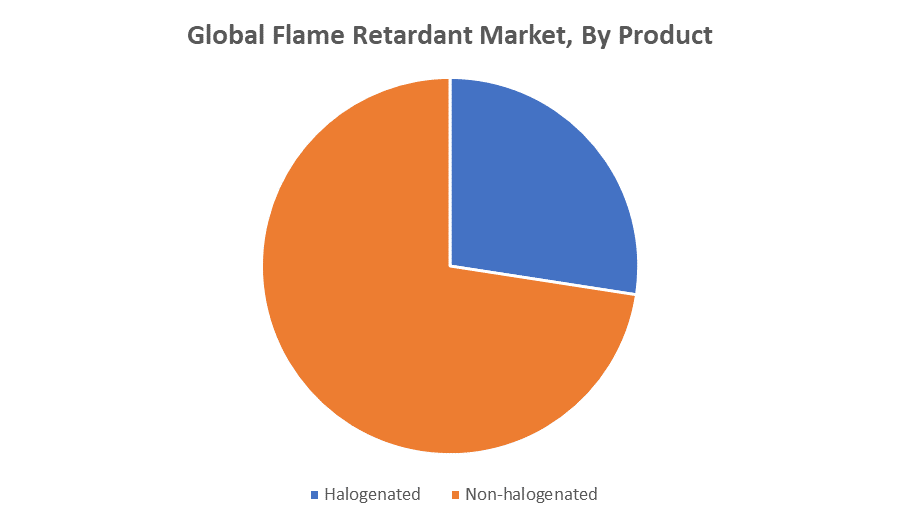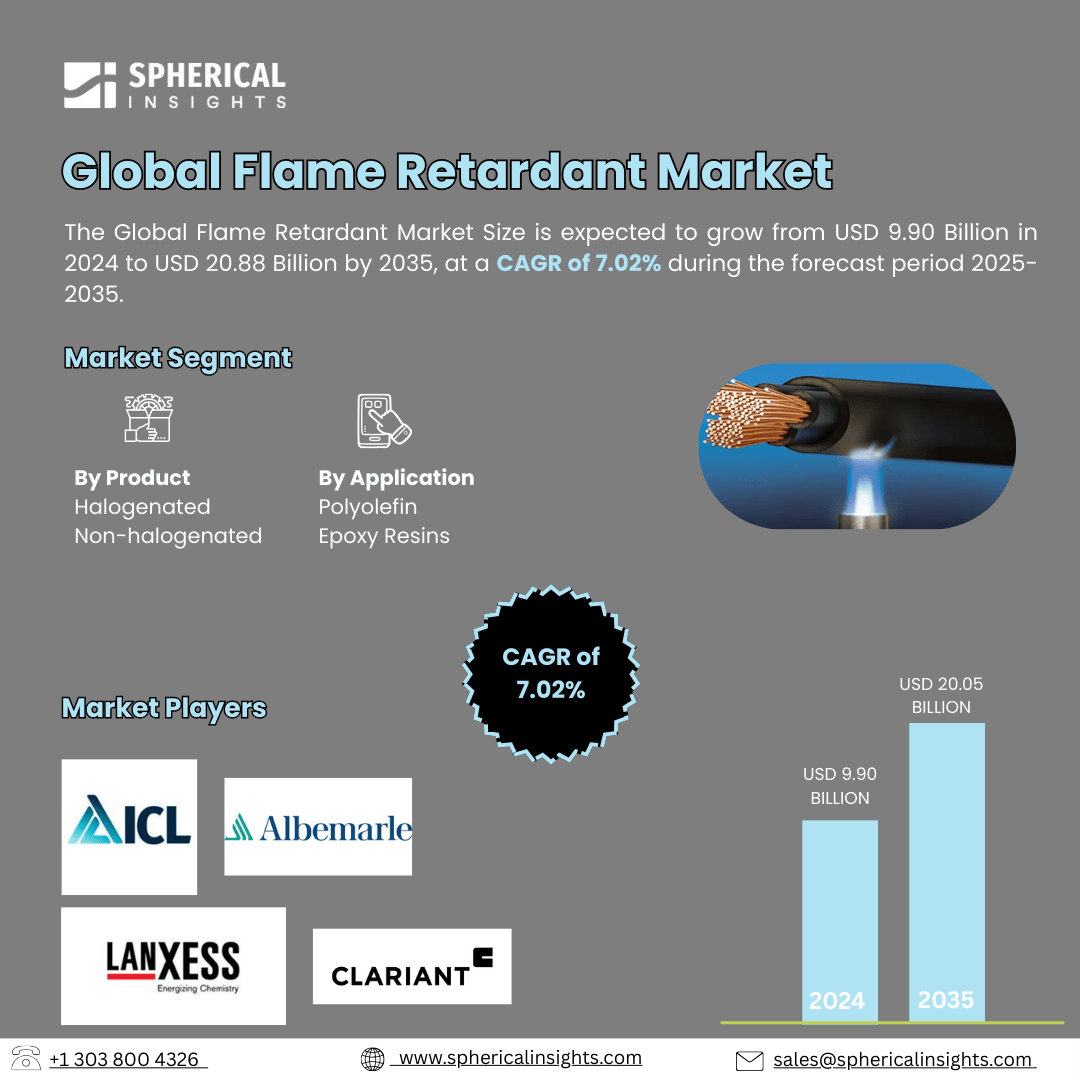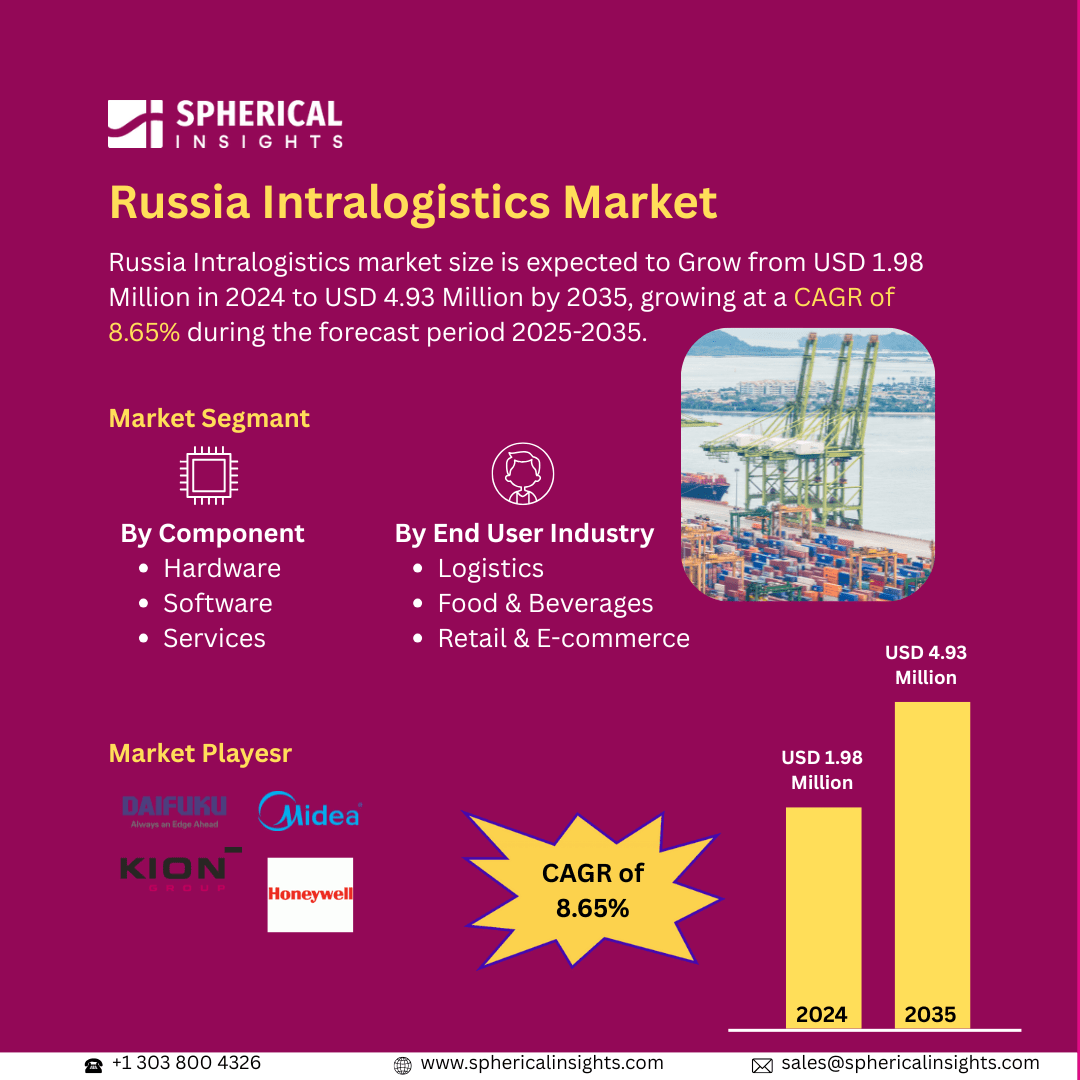Global Flame Retardant Market Insights Forecasts to 2035
- The Global Flame Retardant Market Size Was Estimated at USD 9.90 Billion in 2024
- The Market Size is Expected to Grow at a CAGR of around 7.02% from 2025 to 2035
- The Worldwide Flame Retardant Market Size is Expected to Reach USD 20.88 Billion by 2035
- North America is expected to grow the fastest during the forecast period.

Flame Retardant Market
The global flame retardant market involves the production and use of substances that reduce the flammability of materials and slow the spread of fire. These chemicals are commonly added to products such as plastics, textiles, electronic devices, building materials, and transportation components to improve fire resistance and safety. Flame retardants work by interfering with the combustion process, either chemically or physically, to delay ignition or reduce flame spread. The market includes various types, such as halogenated, non-halogenated, phosphorus-based, nitrogen-based, and inorganic compounds. These materials are available in different forms including additives and reactive types, depending on the application needs. Manufacturers continually invest in product innovation to improve performance and safety while addressing environmental and health concerns. The market serves a wide range of industries including electronics, construction, automotive, and aerospace. As product safety standards evolve, flame retardants remain essential in ensuring compliance and enhancing fire protection across multiple sectors.
Attractive Opportunities in the Flame Retardant Market
- There is a growing demand for eco-friendly and non-toxic flame retardants as industries face increasing environmental regulations and consumer pressure for greener products. Investing in research and innovation to develop bio-based, biodegradable, and sustainable flame retardants offers a strong competitive advantage. These products appeal to environmentally conscious customers and comply with stricter regulatory standards, opening new market segments and driving long-term growth.
- Emerging industries like wearable electronics, smart textiles, and electric vehicles present significant growth opportunities for flame retardant manufacturers. These sectors require specialized, high-performance flame retardant materials to ensure safety without compromising flexibility or functionality. Additionally, the increasing focus on recycling and circular economy principles creates demand for flame retardants compatible with recycled materials, allowing companies to innovate and capture new customer bases.
Global Flame Retardant Market Dynamics
DRIVER: Rising use of polymers and plastics
Increasing demand for fire-safe materials across industries such as construction, electronics, automotive, and aerospace significantly contributes to market expansion. Stricter fire safety regulations and building codes worldwide are compelling manufacturers to incorporate flame retardants into a wide range of products. The rapid growth of the electrical and electronics industry, where fire-resistant materials are essential, is also fueling demand. Additionally, the rising use of polymers and plastics, which are inherently flammable, has led to a greater need for flame retardant additives. Ongoing urbanization and infrastructure development further boost market growth by increasing the use of construction materials requiring fire protection. Innovation in eco-friendly, non-halogenated flame retardants is attracting more users concerned with environmental impact and safety. The continuous development of high-performance, sustainable materials ensures the flame retardant market maintains steady growth across multiple end-use industries.
RESTRAINT: Environmental and health risks associated with certain types of flame retardants
One major concern is the environmental and health risks associated with certain types of flame retardants, particularly halogenated compounds, which can release toxic and persistent chemicals during production, use, or disposal. This has led to increasing regulatory scrutiny and restrictions on hazardous flame retardants in many regions. Additionally, the high cost of advanced, eco-friendly flame retardants can limit their adoption, especially in price-sensitive markets. The complexity of integrating flame retardants without compromising the physical properties or performance of end products also poses challenges for manufacturers. Furthermore, the development of alternative fire prevention technologies and materials may reduce reliance on traditional flame retardants over time. Limited awareness and adoption of flame retardants in some emerging markets also hinder growth. These factors collectively contribute to slower market expansion and push the industry to innovate safer and more cost-effective solutions.
OPPORTUNITY: Expanding applications in emerging sectors such as wearable electronics
The flame retardant market presents several opportunities beyond the usual growth drivers. One key opportunity lies in the development of bio-based and sustainable flame retardants that address growing environmental concerns and regulatory pressures. As industries seek greener alternatives, companies investing in research for non-toxic, biodegradable flame retardants can gain a competitive edge. Additionally, expanding applications in emerging sectors such as wearable electronics, smart textiles, and electric vehicles offer new avenues for market growth. The increasing focus on recycling and circular economy principles also creates demand for flame retardants compatible with recycled materials. Moreover, digital technologies and advanced manufacturing techniques, like nanotechnology and additive manufacturing, provide opportunities to enhance flame retardant performance and tailor solutions to specific industry needs. Collaborations between chemical manufacturers and end-users for customized flame retardant solutions further open doors for innovation and market penetration, particularly in specialized and high-performance applications.
CHALLENGES: Environmental and health concerns about traditional halogenated flame retardants
Environmental and health concerns about traditional halogenated flame retardants, linked to toxicity and persistence, have led to strict regulations and a shift toward safer alternatives. However, non-halogenated and bio-based flame retardants often come with higher production costs due to expensive raw materials and complex manufacturing processes, limiting their adoption in price-sensitive sectors. Supply chain volatility also poses risks, as fluctuations in prices and availability of essential raw materials like bromine and phosphorus compounds can disrupt production and affect profitability. Additionally, manufacturers must navigate a complex and evolving regulatory landscape, particularly in Europe and North America, requiring significant investments in compliance, testing, and product reformulation. These factors collectively constrain market growth and profitability, pushing companies to innovate and develop cost-effective, eco-friendly solutions that meet safety standards while addressing environmental concerns.
Global Flame Retardant Market Ecosystem Analysis
The global flame retardant market ecosystem includes raw material suppliers providing key chemicals, manufacturers producing various flame retardant types, and distributors ensuring product availability. End-use industries like construction, electronics, automotive, and textiles incorporate flame retardants to meet safety standards. Regulatory bodies enforce fire safety and environmental rules, while research institutions drive innovation toward eco-friendly solutions. Waste management plays a vital role in handling flame-retardant products' disposal and recycling. This interconnected network balances safety, performance, and sustainability across the market.
Based on the product, the non-halogenated segment accounted for the largest revenue share over the forecast period

Non-halogenated flame retardants, such as phosphorus-based, nitrogen-based, and inorganic compounds, are considered safer and more eco-friendly alternatives. Additionally, stricter regulations worldwide are encouraging manufacturers to shift toward non-halogenated options. These flame retardants also offer effective fire resistance without compromising material performance, making them increasingly popular across industries like construction, electronics, and automotive. The rising demand for sustainable and compliant products is thus driving the strong market preference for non-halogenated flame retardants.
Based on the application, the polyolefins segment accounted for the largest revenue share during the forecast period

Polyolefins, which include materials like polyethylene and polypropylene, are widely used in packaging, automotive parts, electrical insulation, and consumer goods due to their lightweight, durability, and cost-effectiveness. However, these materials are inherently flammable, creating a strong demand for flame retardants to improve their fire resistance. The extensive use of polyolefins across various industries, combined with growing safety regulations, drives the increased incorporation of flame retardants in these applications. As a result, the polyolefins segment dominates the market by revenue, reflecting its critical role in fire safety and regulatory compliance across diverse sectors.
Asia Pacific is anticipated to hold the largest market share of the flame retardant market during the forecast period
Asia Pacific is anticipated to hold the largest market share in the flame retardant market during the forecast period. This dominance is driven by rapid industrialization, urbanization, and expanding manufacturing activities in countries like China, India, and Southeast Asian nations. The region’s growing construction, electronics, automotive, and consumer goods sectors increasingly require flame retardant materials to comply with stringent fire safety regulations. Additionally, rising awareness about fire hazards and government initiatives to enhance safety standards further boost demand. The presence of a large consumer base and investments in infrastructure development also contribute to the region’s strong market position, making Asia Pacific the leading hub for flame retardant consumption globally.
North America is expected to grow at the fastest CAGR in the flame retardant market during the forecast period
North America is expected to grow at the fastest CAGR in the flame retardant market during the forecast period. This rapid growth is driven by stringent fire safety regulations and standards enforced across industries such as construction, electronics, automotive, and aerospace. Increasing consumer awareness about fire hazards and demand for safer, high-performance products further propel market expansion. Additionally, ongoing innovation in environmentally friendly and non-halogenated flame retardants supports adoption in the region. Strong investments in research and development, coupled with growing industrial activities, position North America as a fast-growing market for flame retardants.
Recent Development
- In September 2024, Asahi Kasei introduced a new grade of LASTAN™, a flame-retardant and highly flexible nonwoven fabric designed to enhance electric vehicle (EV) battery safety. LASTAN™ offers superior resistance to flames and particle blasts, making it an ideal material for thermal runaway protection in EV battery packs. The fabric can withstand flames up to 1,300°C and impacts from particles ranging from 200 to 500 µm. It also provides electrical insulation up to 3.5 kV and maintains its performance characteristics in sheets as thin as 0.8 mm.
Key Market Players
KEY PLAYERS IN THE FLAME RETARDANT MARKET INCLUDE
- Clariant AG
- Albemarle Corporation
- ICL Group Ltd.
- Lanxess AG
- Chemtura Corporation (now part of LANXESS)
- Huntsman Corporation
- BASF SE
- Ishihara Sangyo Kaisha, Ltd.
- FRX Polymers, Inc.
- Shin-Etsu Chemical Co., Ltd.
- Others
Market Segment
This study forecasts revenue at global, regional, and country levels from 2020 to 2035. Spherical Insights has segmented the flame retardant market based on the below-mentioned segments:
Global Flame Retardant Market, By Product
- Halogenated
- Non-halogenated
Global Flame Retardant Market, By Application
Global Flame Retardant Market, By Regional Analysis
- North America
- Europe
- Germany
- UK
- France
- Italy
- Spain
- Russia
- Rest of Europe
- Asia Pacific
- China
- Japan
- India
- South Korea
- Australia
- Rest of Asia Pacific
- South America
- Brazil
- Argentina
- Rest of South America
- Middle East & Africa
- UAE
- Saudi Arabia
- Qatar
- South Africa
- Rest of the Middle East & Africa






